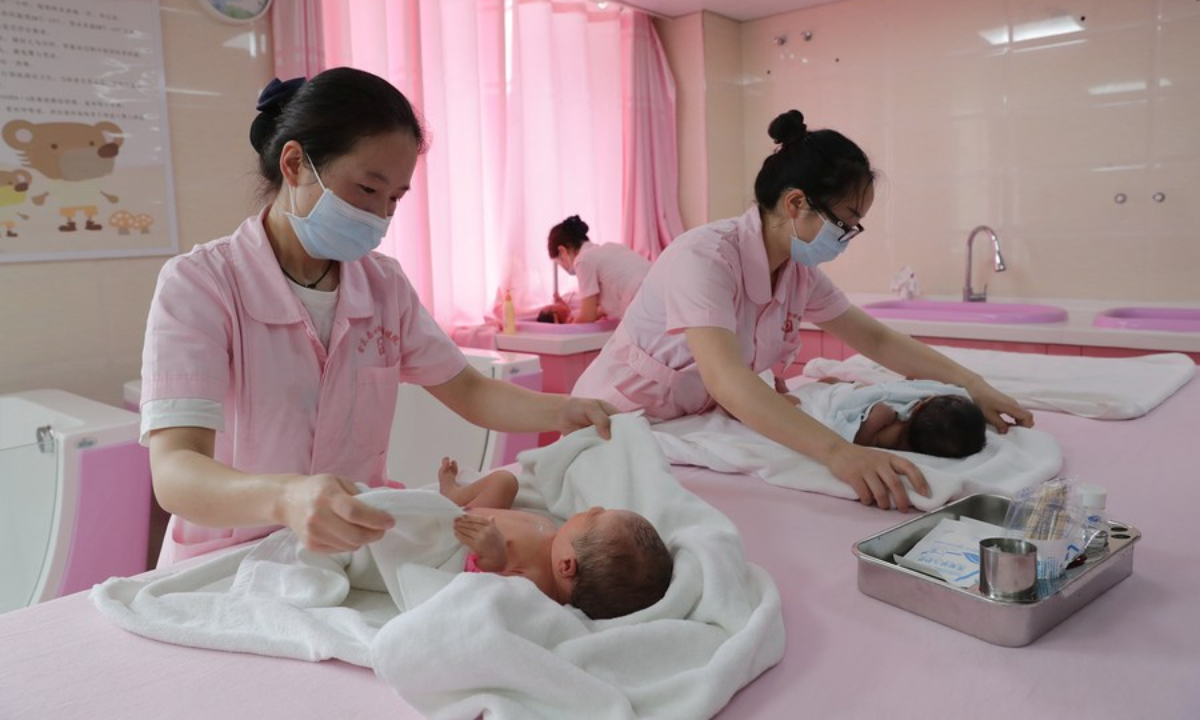
Nurses take care of newborn babies at a hospital in Zunyi, southwest China's Guizhou Province. Photo:Xinhua
Chinese demographers on Tuesday proposed reshaping fertility support policies to support childbearing women to give birth and promote high-quality population development in response to the established reality of long-term negative population growth in the country.
The advice from demographers came on Tuesday, one day before the National Statistics Bureau was scheduled to release the annual population data of 2023. Most demographers believed that the 2023's annual new birth population will continue to decrease.
Yuan Xin, deputy head of the China Population Association and a demographer from Nankai University in Tianjin, said that in 2024, the negative population growth may be alleviated to some extent due to Chinese people's preference toward the Year of the Dragon and a birth rebound after the three-year COVID-19 pandemic. He made the remarks at a Tuesday seminar organized by the China Population Association.
The three-year COVID-19 pandemic, a decrease in the number of women of childbearing age, weak fertility desires, delayed marriage and childbearing are factors that contributed to the negative population growth in 2023, Yuan noted.
"After the COVID-19 restrictions were lifted in the end of 2022, the country experienced a peak of positive infection cases that lasted for about three months. Infected young people were advised to avoid getting pregnant for three to six months for health reasons," Yuan told the Global Times.
One main reason behind the negative population growth is the decline in the number of women choosing to have children. According to He Dan, director of China Population and Development Research Center, one survey conducted by her center showed that the average ideal number of children for women of childbearing age dropped from 1.95 in 2017 to 1.86 in 2022, and the number of children they intend to have dropped from 1.77 to 1.74.
He Dan believes most factors that result in the decline in women choosing to have children or get married can be adjusted through the implementation of supportive policies. "Though cities have released a slew of supportive policies to support childbearing women to give birth, the public's expectation is still not being met,"
He Dan emphasized.
From central government to local governments, many fertility support policies have been released, but overall the current policies lack coordination among different levels and regions, Yang Fan from Center for Population and Development Studies of Renmin University of China told the seminar.
In order to achieve the goal,
He Dan emphasized the need for a "systematic policy reshape" in China.
He Dan suggested that the current supportive birth policies undergo an "all-round" adjustment to improve birth rates, such as reducing living expenses, alleviating educational anxiety and promoting female employment.
One proposed birth guarantee system by He Dan is to provide subsidies to individuals who care for newborns, aiming to encourage intergenerational support and help between family members, and strengthen training and guidance on scientific parenting.
Meanwhile,
He Dan believed the establishment of "entire lifecycle of family services support system" will be able to alleviate anxiety and stress related to childbirth, and provide comprehensive support for reproductive health services, marriage and relationship services, childcare services, among others.
"We should be aware that supporting birth is a mission that needs long-term persistent efforts and their results cannot be achieved overnight," Yang said.
Though the long-term population decline trend has already become an established fact, Li Yue, a demographer from China Population and Development Research Center, emphasized there are still some positive factors in China's demographic situation.
First of all, Li said, according to census data of 2020, the lifetime fertility level of women of childbearing age in China is 1.6. The fertility within marriage is high and the proportion of lifetime childlessness is low, meaning a high fertility potential.
In addition, Li noted that the number of marriage registrations in each quarter of 2023 is higher than the same period in 2022, and the number of marriage registrations in the whole year may return to more than 7 million pairs.
Yuan noted that facing a negative population growth, in the middle of this century, China will still be one of the two billion-level populous countries in the world, with a population of about 1.2-1.4 billion people.
China's population peaked at 1.413 billion in 2021-22. If the fertility rate gradually increases to 1.8 by 2050, the population will be around 1.4 billion. A fertility rate of 1.4-1.5 would result in a population of around 1.3 billion, while a rate of 0.8-0.9 would lead to a population of around 1.2 billion, according to Yuan.
"In short, in the next 30 years, China's modernization will lead 12-14 billion people, accounting for about 14-18 percent of the global population, into a modernized country," Yuan said. "Such a large-scale modernization process with such a huge population is unprecedented."




